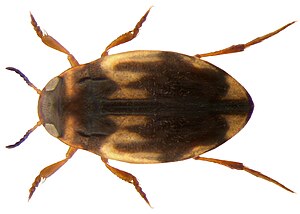Yellow-brown dwarf swimmer
| Yellow-brown dwarf swimmer | ||||||||||||
|---|---|---|---|---|---|---|---|---|---|---|---|---|

Yellow-brown dwarf swimmer ( Hydroglyphus pusillus ) |
||||||||||||
| Systematics | ||||||||||||
|
||||||||||||
| Scientific name | ||||||||||||
| Hydroglyphus pusillus | ||||||||||||
| ( Fabricius , 1781) |
The yellow-brown dwarf swimmer ( Hydroglyphus pusillus , synonyms : Guignotus pusillus , Hydroglyphus geminus ) is a swimming beetle and belongs to the smallest species of the family with the five species of the genus Bidessus found in Central Europe and another species of the genus ( Hydroglyphus hamulatus ). The beetles are only 1.75 to 2.25 mm in size.
features
The yellow-brown dwarf swimmer is slimmer than Bidessus unistriatus . It is drawn very variably with different proportions of dark brown and yellow brown. The underside is dark brown to black. The head and thorax are largely dark brown, the pronotum is lighter yellow-brown with a dark band on the front and rear edges (in the related Hydroglyphus hamulatus , it is monochrome yellow-brown). There is a sharply delimited dark stripe (seam stripe) along the wing cover seam. In the back half of the elytra on both sides there is a large and a very small dark spot, which can often run into one another as a continuous zigzag band.
Similar species
- Bidessus unistriatus
- Smooth ball float ( Hyphydrus ovatus )
ecology
The species occurs in a variety of habitats, including both flowing and standing water, and is often found in temporarily drying out (temporary) bodies of water. Females of the species lay their eggs individually over a longer period of time. The larval development is complete in six to eight weeks. The adult beetles are good fliers and regularly leave their often short-lived living waters to look for new habitats. Flying beetles can be detected frequently and regularly with window traps.
Both the adult beetles and their larvae live as predators (predators). In addition to mosquito larvae, the range of prey also includes small planktonic crustaceans such as water fleas and hippos, including their larval stages.
distribution
The animals are common and quite common across Europe, from Scandinavia to the Mediterranean. They are also found in most of Asia, east to China.
Economic importance
The beetles are of great importance as predators of mosquitoes , e.g. B. also of the genus Anopheles . You belong e.g. B. in rice fields of the Po Valley to their most important predators. Other species of the genus have a similar meaning in Asian rice fields.
swell
literature
- Harde, Severa: The Kosmos Käferführer . Franckh-Kosmos Verlags-GmbH & Co KG, Stuttgart 2009, ISBN 978-3-440-12364-5 .
- Genus Hydroglyphus. in: Beetles of Europe
- ↑ Wilco CEP BVerberk, Henk Siepel, Hans Esselink (2008): Life-history strategies in freshwater macroinvertebrates. Freshwater Biology Volume 53, Issue 9: 1722-1738. doi : 10.1111 / j.1365-2427.2008.02035.x (open access)
- ↑ Lundkvist Elisabeth; Landin Jan; Karlsson Fredrik (2002): Dispersing diving beetles (Dytiscidae) in agricultural and urban landscapes in south-eastern Sweden. Annales zoologici Fennici vol. 39, no 2: 109-123.
- ↑ Siegfried Kehl & Konrad Dettner (2003): Predation by pioneer water beetles (Coleoptera, Dytiscidae) from sandpit ponds, based on crop-content analysis and laboratory experiments. Archives for Hydrobiology, Volume 158, Number 1: 109-126.
- ↑ Wang Miao, Ji Lanzhu, Zhao Ming, Li Qiurong, Chen Xin (1998): Diversity of aquatic beetles in mountainous regions of northeastern China. Chinese Journal of applied ecology 1998/4
- ↑ Bellini, R .; Pederzani, F .; Pilani, R .; Veronesi, R .; Maini, S. (2000): Hydroglyphus pusillus (Fabricius) (Coleoptera Dytiscidae): its role as a mosquito larvae predator in rice fields. Bollettino dell'Istituto di Entomologia `Guido Grandi 'della Università degli Studi di Bologna Vol. 54: 155-163.